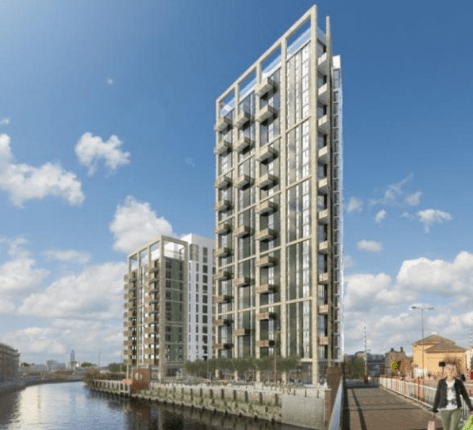
A survey of 230 home builders revealed 67 percent agreed that off-site construction will play an important role in new home supply.
At the Elements factory in Telford, Shropshire, workers are making modules that will comprise a 23-story high rise for Greenwich, in southeast London. Each module requires seven days to complete—including electrical and plumbing, furnishings, everything down to coat hooks and soap dish—and on the eighth day it is ready to be transported to the site and craned into place.
Mark Farmer, founder of advisory group Cast, estimates that just 15,000 homes are constructed off-site a year, but large companies entering the market, such as Legal & General, and Laing O’Rourke indicate the landscape for modular home building is rapidly expanding.
With 20 modules arriving each week at Greenwich, 632 of the units will be stacked on top of each other, plugged into a concrete core. Each apartment is comprised of two or three modules, which can be built as large as necessary, providing they can be lorried (trucked) to the site.
Workers of all trades assemble up to 700 homes per year at Elements’ 200,000 sq ft facility.
Fully computerized and automated, Legal & Guardian’s 500,000 sq ft site, which will open later this month at Leeds, will be able to produce 3,000 homes per year. James Lidgate, head of housing at L&G, noting the factory does not require the same skill level as Elements, said, “It is much more akin to the manufacture of cars on a production line.”
Farmer said building modular homes is a means of meeting housing goals given the skills shortage, a shortage that is likely to increase because of a lower reliance on EU labor, after Brexit. “The amount we build with the labour we have needs to improve,” says Farmer. “Productivity has been pretty poor, and we have built in the same way for the last 50-100 years. To offset the critical shortage of labour we need to change the way we construct – and that’s with modular.”
Institutional investors funding off-site construction works best as the private rental sector grows, because the modules are made on a large scale, designs can be repeated, and rental income can come in much quicker because of the six month advantage over site-built housing. Additionally, repeated designs can become increasingly cost effective. This makes off-site methods financially more sound.
Barriers to entering the market are rather high because of the investment required, an investment that stick-built homes do not require. While site-built builders talk about getting into the factory-built homes market, they could just as easily say, according to James Lidgate, head of housing at L&G, “Why invest thousands in a factory when you don’t need to?”
CEO Marc Vlessing of Pocket Living says modular cuts building time by a third, waste is reduced by 90 percent, and is less disruptive in tight urban areas resulting in 60 percent less truck movements. Saying “it is a crucial technology that we should be deploying,” he adds, “We need the right manufacturers to gain widespread support so consumers and lenders can have complete confidence on the quality of the end product.”
As American factory home builders consider the numbers being considered in England, here in the U.S., manufactured housing may hit some 80,000 homes (+/-) in 2016, and markedly fewer single family modular homes are currently being bulit. Upside domestic potential, anyone? ##
(Rendering credit:telegraph.co.uk/Elements–23-story modular Greenwich apartment building going up in south east London)


























